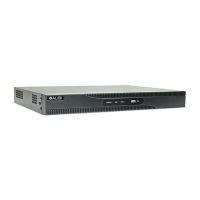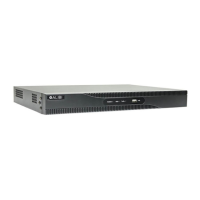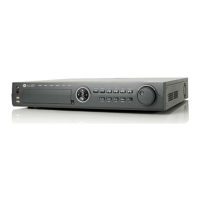Do you have a question about the ALIBI ALI-QVR3000H and is the answer not in the manual?
Details on the on-screen alphanumeric, numeric, and symbol keyboards for inputting data.
Guide to initial recorder configuration using the setup wizard for first-time use.
Instructions on how to access the main menu system via right-click on the live view screen.
Covers adding IP cameras and configuring analog cameras for the system.
Steps to add new IP cameras to the recorder via the live view or main menu.
Procedure for connecting and configuring analog CCTV and HD-TVI cameras to the QVR.
Basic configuration for analog cameras including OSD, image, motion, and privacy mask settings.
Setting OSD labels like camera name and timestamp on the video image.
Adjusting image quality parameters like brightness, contrast for different lighting conditions.
Configuring motion detection areas and sensitivity for specific zones within the video image.
Manual process to check camera video quality using the manual video quality menu.
Managing internal and network storage, including status, configuration, and group modes.
Steps to initialize and configure internal HDDs, including partition or group modes.
Assigning HDDs to groups for camera recordings, requiring QVR reboot.
Setting up system-related alarms like HDD errors, network disconnection, and illegal login.
Detects when a face appears in the video field of view and triggers specific actions.
Detects objects crossing a virtual line, configurable for direction and duration.
Identifies objects entering a predefined virtual quadrangle within the video image.
Essential procedures for starting, stopping, and restarting the QVR system.
Steps for properly powering on the QVR unit.
Procedure for safely shutting down the QVR system via the menu.
Instructions on how to restart the QVR system through the shutdown menu.
Configuring the display resolution for VGA and HDMI monitors connected to the QVR.
Accessing system functions like menu, screen switching, and camera adding via right-click.
Using the toolbar for quick access to functions like recording, playback, and PTZ control.
Setting up camera parameters for continuous and event recording modes.
Configuring mainstream and substream recording parameters for each camera channel.
Automatically starting and stopping recording at preset times for each camera.
Reviewing recorded video from one or multiple cameras, and downloading to a computer.
Instructions for playing back recorded video for specific camera channels.
Selecting a specific date and time to find and play back recorded video segments.
Searching and playing back recordings based on event types like motion detection or alarms.
Exporting recorded video clips and logs to USB storage devices for backup.
Exporting specific video clips by searching based on time and camera channel.
Configuring the RS-485 interface to communicate with PTZ cameras.
Accessing and using the PTZ control panel for camera movement and features.
Configuring camera positions (presets), movement sequences (patrols), and recorded movements (patterns).
Setting specific camera positions to be recalled later for quick access.
Enabling and configuring the horizontal scan range for PTZ cameras.
Steps to remove existing user accounts from the system.
Modifying user account details, permissions, and MAC address filtering.
Setting up network parameters like IP address, subnet mask, and gateway.
Enabling and configuring Dynamic DNS (DDNS) for remote access to the QVR.
Setting up a Network Time Protocol server for accurate system date and time synchronization.
Configuring email notifications for alarms, events, or password changes.
Displays status reports of the QVR, cameras, network, and HDDs.
Accessing and viewing system event logs, including alarms and exceptions.
Searching and filtering system logs for specific entries and events.
Exporting current system settings and importing them to restore previous configurations.
Procedures for updating the QVR firmware via local device or FTP server.
Tools for diagnosing network connectivity and performance issues.
Performing network tests to measure delay and packet loss to connected destinations.
Monitoring the current network status and parameters of the QVR.
Instructions for accessing the QVR from another computer on the local network.
Viewing live camera feeds remotely, with options for screen layout and stream selection.
Remotely reviewing recorded video, with controls for time, channel, and playback.
Accessing and modifying QVR settings remotely via the web interface.
Details on the on-screen alphanumeric, numeric, and symbol keyboards for inputting data.
Guide to initial recorder configuration using the setup wizard for first-time use.
Instructions on how to access the main menu system via right-click on the live view screen.
Covers adding IP cameras and configuring analog cameras for the system.
Steps to add new IP cameras to the recorder via the live view or main menu.
Procedure for connecting and configuring analog CCTV and HD-TVI cameras to the QVR.
Basic configuration for analog cameras including OSD, image, motion, and privacy mask settings.
Setting OSD labels like camera name and timestamp on the video image.
Adjusting image quality parameters like brightness, contrast for different lighting conditions.
Configuring motion detection areas and sensitivity for specific zones within the video image.
Manual process to check camera video quality using the manual video quality menu.
Managing internal and network storage, including status, configuration, and group modes.
Steps to initialize and configure internal HDDs, including partition or group modes.
Assigning HDDs to groups for camera recordings, requiring QVR reboot.
Setting up system-related alarms like HDD errors, network disconnection, and illegal login.
Detects when a face appears in the video field of view and triggers specific actions.
Detects objects crossing a virtual line, configurable for direction and duration.
Identifies objects entering a predefined virtual quadrangle within the video image.
Essential procedures for starting, stopping, and restarting the QVR system.
Steps for properly powering on the QVR unit.
Procedure for safely shutting down the QVR system via the menu.
Instructions on how to restart the QVR system through the shutdown menu.
Configuring the display resolution for VGA and HDMI monitors connected to the QVR.
Accessing system functions like menu, screen switching, and camera adding via right-click.
Using the toolbar for quick access to functions like recording, playback, and PTZ control.
Setting up camera parameters for continuous and event recording modes.
Configuring mainstream and substream recording parameters for each camera channel.
Automatically starting and stopping recording at preset times for each camera.
Reviewing recorded video from one or multiple cameras, and downloading to a computer.
Instructions for playing back recorded video for specific camera channels.
Selecting a specific date and time to find and play back recorded video segments.
Searching and playing back recordings based on event types like motion detection or alarms.
Exporting recorded video clips and logs to USB storage devices for backup.
Exporting specific video clips by searching based on time and camera channel.
Configuring the RS-485 interface to communicate with PTZ cameras.
Accessing and using the PTZ control panel for camera movement and features.
Configuring camera positions (presets), movement sequences (patrols), and recorded movements (patterns).
Setting specific camera positions to be recalled later for quick access.
Enabling and configuring the horizontal scan range for PTZ cameras.
Steps to remove existing user accounts from the system.
Modifying user account details, permissions, and MAC address filtering.
Setting up network parameters like IP address, subnet mask, and gateway.
Enabling and configuring Dynamic DNS (DDNS) for remote access to the QVR.
Setting up a Network Time Protocol server for accurate system date and time synchronization.
Configuring email notifications for alarms, events, or password changes.
Displays status reports of the QVR, cameras, network, and HDDs.
Accessing and viewing system event logs, including alarms and exceptions.
Searching and filtering system logs for specific entries and events.
Exporting current system settings and importing them to restore previous configurations.
Procedures for updating the QVR firmware via local device or FTP server.
Tools for diagnosing network connectivity and performance issues.
Performing network tests to measure delay and packet loss to connected destinations.
Monitoring the current network status and parameters of the QVR.
Instructions for accessing the QVR from another computer on the local network.
Viewing live camera feeds remotely, with options for screen layout and stream selection.
Remotely reviewing recorded video, with controls for time, channel, and playback.
Accessing and modifying QVR settings remotely via the web interface.
| Model | ALI-QVR3000H |
|---|---|
| Video Input Channels | 16 |
| Video Output | HDMI, VGA |
| Resolution | 1920x1080 |
| Remote Access | Yes |
| Operating System | Embedded Linux |
| USB Interface | 2 x USB 2.0 |
| Power Supply | 100-240VAC, 50/60Hz |
| Compression Format | H.265, H.264 |
| Network Interface | RJ45 10/100/1000Mbps |
| Audio Input/Output | 1 Input, 1 Output |
| Operating Temperature | -10°C to +55°C |












